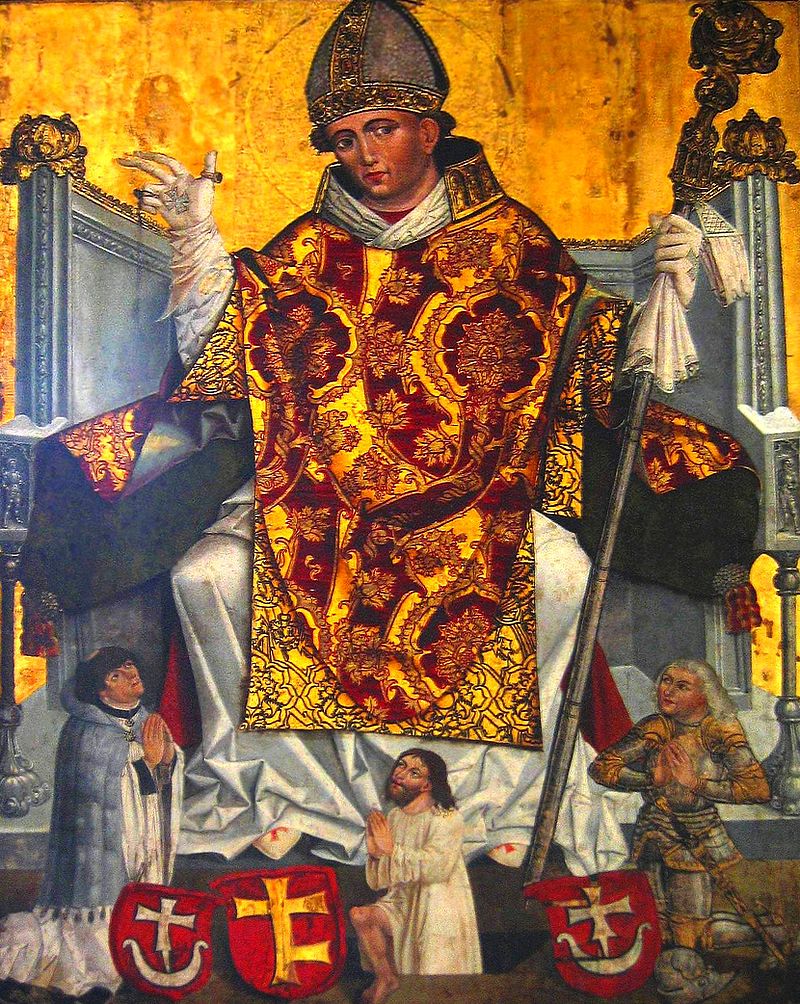
Centuries ago in Krakow, near the royal castle, there was a small lake at Wawel. And above it was a rock, on which the ancient temple stood, built of white stone, of St.. Michael. It was popularly called the church on Skałka. In this church 11 April 1079 r. died of St.. Stanisław the bishop.
Who was Bishop Stanisław ? - Unfortunately, we know little about his life and work. We don't even know his last name. We only know, that he was born in Szczepanów, in the Tarnów diocese and that is why he is often called Szczepanowski. He probably studied abroad. It is for sure, that a year 1072 he was consecrated bishop of Krakow after the death of bishop Lambert. He was martyred at the age of forty.
Why did King Bolesław act so ruthlessly with Bishop Stanisław? ? - This question has been asked more than once. Many historians have already tried to answer them. So far, however, no one has given a comprehensive answer. Some people think, that the bishop of Krakow had different views than King Bolesław and criticized his rule. Others see the cause of the tragedy in the king's anger about it, that Bishop Stanisław dared to admonish him. Soon after his death, Stanisław the bishop was venerated as a saint. Preserved historical documents indicate, that this cult began at the end of the 11th century. And in the next century it expanded and deepened, as conviction grew, that the fragmentation of our country and the constant discord among compatriots are God's punishment for the bishop's death. It was decided to appease God by making efforts for his early canonization. This was especially sought by the Bishop of Kraków, Prandota, and Prince Bolesław the Chaste. The day of the solemn canonization has finally come. It was made by Pope Innocent IV in the Church of St.. Francis of Assisi. This was 17 September 1253 year.
For the canonization ceremony, taking place in Poland, Almost all Polish princes and bishops, as well as huge crowds of pilgrims from all districts and principalities. Although our whole country was shattered, here in Krakow, next to the relics of Saint Stanislaus, everyone realized, that they are children of one Motherland. Thus, St.. Stanisław became the patron of the unity of the Polish nation. Soon after, our country, reunited, grew in strength and importance among other nations.
The cult of St.. Stanisława lasted for centuries and spread even beyond the borders of our country. Certain doubts and objections arose only at the end of the 19th century, when is one of our historians (Tadeusz Wojciechowski) published the results of his research on the "case of St.. Stanislaus ", based on a different translation of the words of the chronicle of Gall-Anonymus, who described this tragic event.
Gall-Anonym wrote in Latin. In Polish, the text of his chronicle relating to this matter is as follows :
“As king, Bolesław was expelled from Poland, there would be a lot to tell about it, but say it slowly, that the anointed should not have attained any sin fleshly upon the anointed. It did him a great deal, that for treason he handed over the bishop to be cut off. For let us not justify a traitor to a bishop, nor should we plead against a king who avenges so badly - but let us also give up in the middle and tell, as it was adopted in Hungary ".
The Latin word "traditor" caused the most disputes, which T.. Wojciechowski, and behind him also some other scholars translated as "traitor". And on this one word they then based their objection, supposedly St.. Stanisław was a traitor to the nation and the king. The chronicler Gall was about to - in their opinion - testify to the existence of such an opinion after the bishop's death.
Meanwhile, we know from various historical sources, that the vast majority of Polish society condemned the crime committed by King Bolesław the Bold and admitted that the bishop was right. This is evidenced by the king's forced escape to Hungary and the cult of St.. Stanislaus.
Many scholars who study "the case of St.. Stanisława ”he recalls, that the Latin word "traditor" has to be translated differently, for it has many other meanings as well. This was the name of e.g.. this man, who rebelled, that is, he opposed some authority, treating subjects unfairly. Many historians consider such a rebellion to be right today, because it was intended to prevent the unjust rule of the king over his subordinates. The traitor was this one, who acted to the detriment of his own nation.
When we carefully read the description of "the case of St.. Stanislaus ", found in the chronicle of Gall-Anonim, we come to the conviction, that the chronicler meant rebellion rather than treason. The law of that time, both church and state, it did not allow the king to kill a priest for a crime. These people were judged by a synod of the ecclesiastical province. That is why the king's attacking the life of Stanisław Bishop was considered a sacrilege.
The whole thing is very complicated and it is difficult to finally settle it after so many centuries. After all, it is impossible to accurately recreate the events of almost ten centuries ago, especially since there are so few sources, to lean on. The research results so far have not allowed to establish certain facts.
And modern history can explain little to us "the case of St.. Stanislaus ". The cult of the holy bishop, which lasts for so many centuries and is still very much alive, speaks for the rightness of his attitude.
In the Krakow church on Skałka, in the wall next to the altar of St.. Stanislaus, a stone is laid today, with such an inscription in Latin : “Haven passerby, the holy bishop sprinkled me with his blood ".